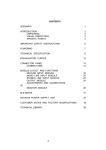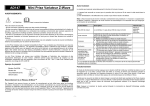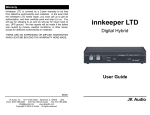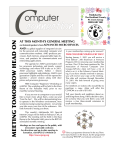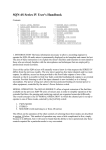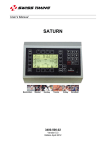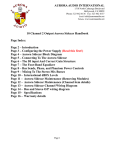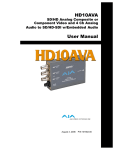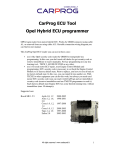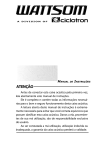Download AD147
Transcript
CONTENTS SCENARIO 1 INTRODUCTION UNPACKING VISUAL INSPECTION SPECIFIC POINTS 3 3 3 3 IMPORTANT SAFETY INSTRUCTIONS 6 POWERING 7 TECHNICAL SPECIFICATION 8 EQUALISATION CURVES 10 CONNECTOR PANEL CONNECTIONS 12 13 MODULE LAYOUT AND FUNCTIONS MIC/LINE INPUT MODULE OUTPUT MODULE ADJUSTMENTS AND CALIBRATIONS MONITOR MODULE 16 20 22 26 M-S NOTES 29 AD100-09 POWER SUPPLY UNIT 34 CUSTOMER NOTES AND FACTORY MODIFICATIONS 35 TECHNICAL LIBRARY SCENARIO Time was when it became necessary to update the ubiquitous AD145 PICO mixer. Our survey showed two main requirements: as well as Audio Developments' build and audio qualities, narrower and shorter modules were required, and the simple but effective equaliser from PICO had to be retained. By this time, 4-track recording equipment had begun to trickle into the marketplace (Nagra D etc), so we decided to give the new mixer four outputs. Because of the lower noise-floor of modern digital recorders, the level of input signals may be reduced. We have taken advantage of this fact and lowered the slope ratio of the limiters to 7:1. By so doing, not only is signal distortion greatly reduced, but also the artefacts associated with limiters become much less noticeable or objectionable. Also, sixty years after the event, sound engineers have come to realise the potential of Blumlein's M-S techniques; to this end, facilities have been incorporated to take advantage of these techniques. The result is AD146 - a four-output mixer. This was followed by AD148 - edit mixer. Based on AD146, two comprehensive left and right monitor modules have been added for editing purposes. If a mic/line module is included for commentary or voice-over purposes, its input-gain switch can be changed to a potentiometer, and its gain structure changed to ensure consistent level matching with a fixed, mechanical point of reference. Unfortunately, this way of working does reduce headroom and also compromises a mixer's noise performance. After AD146/AD148 it was back to the drawing board. Our customers were still demanding a two-output mixer - as a true replacement for the PICO, and with the PICO's simplicity. Despite past assurances to the contrary, T powering is still required. And could we incorporate auxiliaries? And could we possibly bring it to market at 'entry level'? We have, and we have and that's MERCURY (AD147). AD149 completes the 140 series of mixers, and has a repertoire of party tricks not to be found in any other mixer - not even for 'ready money'. The design team took, as its starting point, our list of all the ideas and suggestions presented to us over the past few years. Many of these requests came from film-sound recordists - a sub-set of recordists we have unintentionally neglected in the past. Since the days of R & D for AD146, channel insert points suddenly became de rigueur. It transpires that many sound engineers have experienced the power of FLEX-EQ, our industrial-strength equaliser, and wish to be able to use it when making original recordings. 1 Being latter-day converts, we have included circuitry to take full advantage of all M-S techniques - even shuffling - in both production and post-production. AD149 is Audio Developments' Blumlein. tribute to, and celebration of the genius of Alan We appeal to all AD149 users to break with tradition and, just on this occasion, study the manual to reveal all the mixer's secrets. THIS IS ESSENTIAL. Well - we HAD every intention that AD149 would complete the 140 series. We'd reckoned, however, without the persistence - nay, insistence - of our customers for a mains-operated version of the AD146 with four auxiliaries ... we've called it AD144. 2 INTRODUCTION Unpacking If there are any signs of damage to the outside of the carton, please notify us or your supplier immediately, regardless of the unit's apparent physical condition. This is in case a claim has to be made at a later date because of previously undetected transit damage. The packaging material should not be discarded until the mixer has been acceptance tested and a suitable transit/storage case is available for secure, safe storage. Visual Inspection Identification - please make a separate note of the serial number for your own capital equipment records. Ensure that it agrees with the number on the invoice/packing note. The serial number label is on the back cover, adjacent to the battery compartment. Configuration - check that the correct number and combination of input modules have been installed. If, for any reason, you wish to change the positions of the modules, do not do so until after completion of any acceptance tests. Any tests then made will be to a known configuration and can be compared with our factory records. Temperature - check the meter glasses for condensation. If the package has been in transit during cold weather, leave the mixer for at least 12 hours to allow it to return to normal room temperature. Any measurements or subjective tests then made, will be to a known temperature reference. Specific Points Battery compartment - the mixer has an integral battery compartment to accept 10 size-C cells, and is formed as part of the bottom transversal extrusion. This helps to lower the centre of gravity, as well as adding to the rigidity of the frame. DC-DC converter - is mounted on the top side of the battery housing and is underneath the fader section of the output and last four input modules. In order to facilitate the testing and calibration of all modules, a set of two extender modules is available from the factory. 3 Fuses - to protect the mixer and internal power supply are mounted on the power supply/converter board. Access is gained by removing the output module. 20mm, 1A ANTI-SURGE HRC fuses are used - one for the internal battery power supply and one for the external DC supply. Until the mixer has been acceptance tested we strongly recommend that modules are not removed for adjustment. If adjustments are necessary, refer to the section on adjustments and calibration. All customer functions are external, except the following. Limiter threshold - is set at the factory at +8dBu (PPM 6), but an internal preset potentiometer allows adjustment to any other level above 0dBu. The limiters are to be found on the left-hand PCB of the output module. Reverse-talkback output - is set at the factory to provide a mono mix of monitor 1 left and right outputs, rather than mute, when the main talkback switch is released. This function can be disabled by the DIL switch to be found on the left-hand PCB of the monitor module. Line-up tone - at 1kHz and 10kHz is calibrated on the meters to PPM4, giving a line output level of 0dBu with L/R and AUX 1/2 controls set to maximum. NOTE - PPM4 refers to the mark on a BBC PPM Scale. Other meter scales have a different mark at 0dBu level. Alternative calibration levels are possible via the internal preset. LH-output ident - as an alternative to continuous tone on both left and right outputs (and AUX 1/2 outputs), the LH and AUX 1 outputs can be pulsed with tone for three seconds. Microphone powering - the mixer will remain unconditionally stable if the powering on unterminated input channels is switched off - this also improves the noise performance and crosstalk. Powering - 48v phantom or 12v tonader - may be selected before or after the microphone is connected to the module. . 4 Module fix screws - Hexagon head screws are used to fix the modules and back cover. The size being 1.5mm HEX A/F with a 2.5M thread. If it becomes necessary to remove modules or back cover it is strongly advised using a good quality hexagonal head driver. Use of a screwdriver, however desperate, is not recommended. Surfaces - every working surface is covered by a hard plastic membrane which is printed on the reverse side. These surfaces may be cleaned by most solvents, and without fear of the legends being erased. Connectors - for convenience, the connector panel is labelled for reading from above. All connectors are in line with their corresponding module. Every input module is mechanically shielded against radio-frequency interference. Abbreviations PPM VU VR X-Y A-B M-S PCB HPF peak programme meter volume unit variable resistor coincident stereo-microphone spaced-apart stereo-microphone middle-side; techniques and microphone described by A D Blumlein printed circuit board high-pass filter Finally, may we draw your attention to our range of portable, battery-operated audiotoys called PORT-A-FLEX (AD066) which will complement your new mixer. No 1 - broadcast quality compressor/limiter. Nos 3, 7, 8, 10 - distribution amplifiers for microphone- and line-level signals. No 13 - the aforementioned FLEX-EQ in its portable guise. We wish you many trouble-free hours of use from your mixer. As a company, we are fully committed to BS EN ISO 9001. Should you have any problems or require any further information on FLEX-EQ or the M-S microphone technique, please do not hesitate to contact us on 01543 375351 or by fax on 01543 361051. 5 WARNING IMPORTANT SAFETY INSTRUCTIONS The user of electrical products must be familiar with their potential dangers, and fundamental precautions must always be taken. Please read the following text carefully. Power supply units manufactured by Audio Developments Ltd are not user serviceable. There are no user-serviceable parts associated with any such power supply unit. THE OUTER COVERS MUST NOT BE REMOVED Such a power supply unit is solely for use with audio mixers and sound processors hereafter called the equipment - manufactured by Audio Developments Ltd. Always use a cord set accepted by a National Approved Body. EARTHING/GROUNDING: When using an external power supply unit that is connected to the mains supply to drive the mixer it must be CONNECTED TO EARTH. In certain types of malfunction or breakdown, earthing provides a path of least resistance for electric current and considerably reduces the risk of electric shock. DANGER: Incorrect connection of the equipment grounding/earthing conductor can result in the risk of electric shock. Where possible obtain a pre-wired mains lead from a reputable supplier with the correctly fitted mains connector for the type of mains outlet in use; otherwise, one correctly wired and checked by a qualified electrical engineer. If your mains lead is not suitable for the mains outlet, have the correct plug fitted by qualified personnel. The MAINS PLUG of this equipment is the primary disconnect device. Therefore, in the final application, ensure it remains close to the equipment and easily accessible. 6 POWERING The mixer may be powered from either internal cells or an external DC power source. The integral battery compartment requires a total of 10 size-C cells. Access is gained via a captive lid which is retained by two, 90-degree-turn buckles. The lid hinges outwards 45 degrees from the back panel. When installing new cells, the row nearest the hinge should be fitted first. Either conventional dry, or rechargeable nickel-cadmium cells may be used. NICADs may be recharged in situ through the 4-pin POWER IN connector. (The circuit for recharging is already incorporated within the mixer.) A voltage in the range +15v to +24v DC @ 250mA is required on PIN 2 of the POWER IN XLR. When driving the mixer from an external power source, PIN 1 is the 0v connection and a voltage in the range +12v to +15v DC should be supplied to PIN 4. The power source should be capable of delivering approximately 400mA - allowing some capacity for phantom powering. If an external power supply unit (PSU) is to drive the mixer and simultaneously charge a set of NICADs, a current capability of at least 650mA is required. It is poor practice to run a PSU at its limit, therefore we recommend a minimum of 750mA. Audio Developments AD100-09 PSU is a suitable unit. WARNING: When NOT using the PSU (AD100-09) supplied for the mixer, ensure your 4-pin XLR is correctly wired to match the POWER IN connector. Failure to do so may result in the breakdown of the internal DC-DC converter. Make this check even if using a PSU which may have been supplied to you in the past, eg AD100-06. AD100-05 PSU is NOT suitable for use with an AD147 mixer and must not be used. 7 TECHNICAL SPECIFICATION ELECTRICAL REFERENCE 0dB = 775mV at 1kHz unless otherwise stated MAX GAIN MIC LINE MAX INPUT LEVEL MIC @ MAX GAIN -42dB LINE @ MAX GAIN -7dB RETURN (STEREO & TB) INPUT IMPEDANCE MIC LINE RETURN MIC POWERING 48v PHANTOM and 12v TONADER MAX OUTPUT +24dBm (600R LOAD) L/R & AUX 1/2 ELEC. BALANCED +18dBm (600R LOAD) MONITOR 1/2 & TB SEND UNBALANCED OUTPUT IMPEDANCE <60R L/R & AUX 1/2 <20R MONITOR 1/2 <20R TB SEND FREQUENCY RESPONSE +0; -1dB 20Hz to 20kHz MAIN SIGNAL & AUXILIARY PATHS +0; -1.5dB 20Hz to 20kHz MONITOR PATHS EQUALISATION 3 BAND LF; 10dB @ 100Hz MF; 15dB @ 2k8Hz HF; 10dB @ 10kHz HIGH-PASS FILTER -3dB @ 110Hz 12dB/OCTAVE (REFER TO CURVE) HARMONIC DISTORTION <0.03% @ 1kHz 0dBm OUTPUT <0.15% @ 40Hz to 20kHz +15dBm OUTPUT OVERLOAD INDICATOR ILLUMINATES AT +15dB AT THE PRE-FADER POINT CROSSTALK <-70dB 40Hz to 15kHz INTERCHANNEL & INTERGROUP NOISE MIC <-126dB EIN 20Hz to 20kHz 200R SOURCE (WITH RESPECT TO THE INPUT) LINE <70dB SNR 20Hz to 20kHz LIMITER THRESHOLD +8dB RATIO 7:1 ATTACK 2 SETTINGS INTERNALLY SWITCHABLE 1 - 4ms; 2 - 0.8ms RELEASE 2 SETTINGS INTERNALLY SWITCHABLE 1 - 250ms; 2 - 80ms POSITION 1 IS SET AT FACTORY 85dB 50dB MIN GAIN 0 MIN GAIN +30dB 24dB >1k5R >10kR >100kR (STEREO & TB) 8 15dB MAX @ 30Hz VARIABLE TURNOVER Q = 1.2 PEAK & DIP RECIPROCAL 15dB MAX @ 30kHz VARIABLE SLOPE MECHANICAL SIZE 6 I/P 350 325 A B 8 I/P 411 386 10 I/P 482 447 ALL DIMENSIONS IN MILLIMETRES WEIGHT 6 I/P 7.4 8 I/P 8.7 10 I/P 10.0 12 I/P 11.3 ALL WEIGHTS IN KILOGRAMS 9 12 I/P 533 508 EQUALISATION CURVES AD 147 HIGH AND LOW EQ 20 15 10 5 dB 0 -5 -10 -15 -20 10 100 1000 10000 100000 Frequency AD 147 MID AND HPF EQ 20 15 10 5 dB 0 -5 -10 -15 -20 10 100 1000 Frequency 10 10000 100000 This page is blank 11 CONNECTOR PANEL 12 All input and output impedances and levels are to be found in the TECHNICAL SPECIFICATION. All inputs to, and outputs from AD147 are to be found on the connector panel. Module connector (1) accepts balanced microphones. Module connector (2) accepts balanced, line-level inputs. XLR Pin 1 Pin 2 Pin 3 Shield Signal + Signal - In the case of an unbalanced line-input, pins 1 & 3 should be connected. Main (6) and auxiliary (5) outputs are electronically balanced, and are at line-level. When driving unbalanced loads, the mixer outputs may be safely unbalanced by connecting pins 1 & 3. This will not lead to a loss of output level. XLR Pin 1 Pin 2 Pin 3 Shield Signal + Signal - The unbalanced stereo-return enters the mixer on two standard, 'A' type stereo jacks (3), left and right. The unbalanced monitor-outputs are on two standard, 'A' type stereo jacks (4), left and right, at line-level. The monitor 2 (headphones) output appears on an 'A' type stereo jack (8). This output is capable of driving 25R at 0dB. BALANCED JACK Tip Signal + Ring Signal Sleeve Shield MONO UNBALANCED JACK Tip Ring Sleeve Signal + Shield Shield STEREO UNBALANCED JACK Tip Ring Sleeve SUB1 (7) is a subsidiary connector for use with a Nagra IVS. TUCHEL Pin 1 Pin 2 Pin 3 Pin 4 R OUT NC L OUT NC Pin 5 Pin 6 Pin 7 13 NC NC 0v - GND Left Signal Right Signal Shield The 6-pin XLR connector (9) carries all signals to and from an outstation (boom operator, director etc). The return appears only on the headphones output. XLR Pin 1 Pin 2 Pin 3 Pin 4 Pin 5 Pin 6 Audio ground Send + Send Ret + ] Ret - ] Balanced return at line-level Control The talkback-send output has a low output-impedance with a capability of driving headphones of 25 ohms impedance or greater. The internal talkback microphone is routed to the talkback send when the TALKBACK switch is selected - otherwise a mono mix of Monitor 1 is fed to this output. This function is set at the factory but may be disabled by the DIL switch on the left-hand printed circuit board of the monitor module. The return signal from an external source feeds onto the PFL line. This is initiated by grounding the control line (PIN 6) at the external source. Thus, for example, a two-way conversation can take place between mixer and boom operator with the boom operator being able to listen to programme when no communication is taking place. A three-position rocker switch BATT/EXT (10) selects either internal batteries or an external DC power source. Power to the mixer is confirmed by the MIX ON LED on the output module. This LED flashes when the supply voltage falls below the safe operating level of 10v. External powering of the mixer is via a 4-pin XLR (11). XLR Pin 1 Pin 2 Pin 3 Pin 4 0v Charge NC 12-15v DC A suitable external power supply is Audio Developments' AD100-09, but any external DC source must be capable of delivering 750mA at 12v. 14 This page is blank 15 MIC/LINE MODULE 16 The discreet microphone amplifier is a transformerless version of the ultra-low-noise, high-gain amplifier designed for AD146. An input pad or attenuator is rendered unnecessary because the available 40dB gain change is achieved with a single potentiometer acting on the feedback alone. This has the advantage of not degrading signal-to-noise performance as the gain is lowered. The reverse log. law potentiometer ensures low-sensitivity, high-resolution control without all the gain occurring in a small angular deviation. A DC voltage is available for 48v phantom powering (1) and 12v tonader powering (2) of condenser microphones. These two switches are interlocked with tonader power taking precedence over phantom power. The line input is isolated from the microphone power and no damage can be done to external equipment if either or both of the power switches remain selected. Such is the isolation between signal paths, a microphone input (Conn 1) and a line input (Conn 2) may simultaneously be connected to a channel. With line selected (3), the input-gain control at MIN and the fader set at 0dB, the mixer has unity gain, with 10dB gain in reserve. (All output faders must be set at 0dB.) Phase change (4) follows the mic/line selector and is therefore active on both inputs. The high-pass filter (5) follows the input amplifier and is, as above, active on both inputs. The filter has a 12dB per octave slope and is -3dB at 110Hz. This filter is independent of the equaliser. The EQ selector switch (6) routes the signal through the equaliser section. The highfrequency control (19) has an amplitude of 10dB at 10kHz, with variable slope. The mid-frequency control (20) has an amplitude of 15dB at 2k8Hz, with a proportional-Q of 1.2. The low-frequency control (21) has an amplitude of 10dB at 100Hz, with variable turnover. Despite modules being narrower and shorter than those of the PICO we have been able to incorporate an auxiliary section. The two auxiliaries are independent of each other: each has its own on/off switch (7) and (9), pre/post fader selector (8) and (10) and level control (22) and (23). The level controls act purely as attenuators - when set at 10 and sourced post-fader, the auxiliary outputs track with, and are at the same level as the L/R outputs from the module. The auxiliary on/off switches are independent of the channel on/off switches - even when the channel L/R routeing is switched off, pre- and post-fader auxiliary outputs are still available. For additional flexibility, separate switches control the left (12) and the right (13) outputs from the module; the panoramic potentiometer (24) routes the signal proportionately to the left and right mix busses. The monitor 1 path is the true output from the module (independent of any other routeing) and is derived from the output of the panpot, and S-switch (11) if selected. 17 In conjunction with CH (1) and MONO (11) on the monitor module, MON (14) can be used for AFL (after-fader listen) monitoring or SIP (solo-in-place) monitoring procedures which are fully described in the monitor-module section. When monitor 1 is not in use for monitoring per se, it may be set up to create another mix or perhaps a mix-minus. Monitor 1 output automatically appears on monitor 2 (headphones) output. PFL (15) routes the signal at the fader input to monitor 2, ie the headphones output jack. LED (16) indicates when PFL has been selected. PFL takes precedence over any other signals that might be present on the headphones output (monitor 2). The overload LED (17) illuminates 3dB before clipping at the input to the channel fader. The fader is calibrated 10dB down from its fully open position, allowing the operator to work with 10dB of gain in reserve. Faders on adjacent modules can be coupled for stereo operation by the use of standard ganging clips. S - matrix selector (11) creates a matrix amplifier across an adjacent pair of input modules. See also monitor and M-S sections. 18 This page is blank 19 OUTPUT MODULE 20 The meters are to broadcast specification with switchable functions; PPM and VU movements are available to choice. The upper meter (1) reads battery status BATT (8), left and auxiliary 1 output levels, monitor 1 left-output level and PFL. The lower meter (2) reads right and auxiliary 2 output levels, monitor 1 right-output level and PFL. The monitor 1 signal will be the one (or mix) selected on the monitor module. The mixer ON LED (7) will flash when the internal batteries become dangerously low. (Discharged to 10v.) Meter illumination (9) should not be used indiscriminately. Overuse will cause internal batteries to discharge much quicker. Switches (10), (11), (12) are interlocked and select the signal to be metered. With no switches selected, the main left and right outputs appear on meters 1 and 2 respectively. Switch (10) selects auxiliary 1 and 2 to the meters. Switch (11) routes monitor 1 left and right signals to the two meters and overrides switch (10). Switch (12) routes PFL to both meters and overrides switches (10) and (11). Matrix selector (6), see later in M-S NOTES. Switch (13) selects the frequency of continuous line-up tone - 1kHz or 10kHz - to L/R output when (15) is selected and to auxiliary outputs when (16) is selected. In both cases, the line-up tone replaces any signal which may be present on the outputs. If interrupted (14) is selected, continuous tone replaces the signal on the right outputs and three second bursts of tone replace the signal on the left outputs. If desired, interrupted tone can be directed to the right outputs by following the instructions on page 24. Matrix selector (17), see later in M-S NOTES. Auxiliary output levels are controlled by potentiometers (20) and (21). The faders (18), (19) control the level of the main left and right outputs. The calibration point of the various output level controls is where they are fully open. The limiters on the main left and right outputs are switched into circuit as a pair (4) and may be linked for stereo operation (5). The limiter LEDs (3) indicate when limiting is taking place. On the left-hand PCB of the output module are two DIL switches - one for each limiter. These switches affect the attack and release times of the two limiters - fast or slow. When linked, the limiters should have the same settings for attack and release. Threshold and ratio are set at the factory. Technical details of the limiters are to be found in the SPECIFICATION. 21 ADJUSTMENTS AND CALIBRATIONS Refer to component location diagrams in TECHNICAL LIBRARY. Line-up-tone oscillator - the preset (VR4) that adjusts its level at the outputs of the mixer is mounted on the right-hand PCB of the output module and can be adjusted from the copper foil side of the board. Low-battery indicator - the preset (VR3) associated with this facility is mounted on the right-hand PCB of the output module. The low reading is set at the factory and corresponds to a set of batteries having discharged to 10v. On a VU meter, low volts is at 0VU. On a PPM meter it is indicated by a separate marking: yellow on a BBC scale and red on an N10 and SDR scale. Meters - either a VU or a PPM may be selected. A choice of 3 scales is available for the PPM: BBC, N10, SDR. VU meter - there is one preset, on the VU meter PCB, for meter adjustment. Set an input module for a line input and introduce a 1kHz tone from an audio signal generator. Adjust levels to achieve a reading of +4dBu, at a main output, on an AC millivoltmeter - measured across pins 2 & 3 on the output XLR. Switch the appropriate meter to the selected output and adjust the preset to give a reading of 0VU. PPM - the driver PCB has three calibration controls (presets). VR1 adjusts the reference level, VR2 and VR3 adjust the 'law' of the meter. VR2 adjusts the upper sector of the scale and VR3 adjusts the lower sector. To initiate calibration, set each preset to its mid position. BBC Scale - using the tone generator and millivoltmeter as described above, adjust mixer levels for a reading of 0dBu, on the millivoltmeter, from a main output. Switch the appropriate meter to the selected output and adjust VR1 for a reading of 4. Increase the output signal to +8dBu and adjust VR2 for a reading of 6. Decrease the output signal to -8dBu and adjust VR3 for a reading of 2. Repeat this procedure until an accurate set of readings is obtained without further adjustment to any of the presets being required. Now check all points 1 to 7 on the scale to determine whether they are within specification. N10 Scale - for a meter calibration of TEST = 0dBu. With a main-output signal of -6dBu, adjust VR1 to give a meter reading at -6. Increase the signal to +6dBu and adjust VR2 to obtain a meter reading at +6. Lower the output signal to -18dBu and adjust VR3 to obtain a meter reading at -18. Repeat this procedure to obtain an accurate reading at each of these three points. Now check the calibration of all meter points. 22 SDR Scale - with a main-output signal level of -6dBu, adjust VR1 to obtain a reading of -12. Increase the output signal to +6dBu and use VR2 to obtain a reading of 0 on the meter. Lower the output signal to -18dBu and adjust VR3 to give a reading of -24. Repeat the procedure to obtain an accurate reading at each of these three points. Now check all points on the scale for calibration. Main-output limiters - calibration involves two presets per output, to be found on the output module LH PCB. Using the 'L' output as the example… Biasing and threshold are adjusted as follows: VR1 biases the limiter circuit to the point of correct operation and VR2 sets the threshold. (Labelled SET 0 and THR respectively on the left-hand PCB.) Determine whether the left-hand PCB is issue 3 or below, or issue 4 and above. If issue 4+, read ‘PIN 5 of IC1’ instead of ‘PIN 12 of IC1’ in the following paragraphs. (Issue 4+ does not indicate an early improvement in circuitry; simply a change in layout to make testing simpler.) With no signal present, VR1 should be adjusted to give a reading in the range -1.5v to -2.5v at PIN 12 of IC 1. VR2 should be adjusted to give a reading in the range -2.5v to -3.5v at PIN 10 of IC 1. Apply a signal at 1kHz to the mixer to give a level of 0dBu at 'L' output. Then select the limiter function and adjust VR1 until the output signal starts to fall, (typically 0.2dB). The DC voltage at PIN 12 of IC 1 should be approximately -2.0v. After setting VR1, adjust the output signal to just greater than +8dBu with the limiter deselected. Introduce the limiter and adjust VR2 until the output signal falls to +8dBu. This is the THRESHOLD setting. (If a different threshold setting is required, alter the signal levels accordingly.) The DC voltage at PIN 10 of IC 1 should be approximately 0.6v different from that at PIN 12. 23 The right output can be set using the above procedure, but the preset and IC numbers change to correspond with the output being calibrated. 24 The link function has no individual setting of its own. To ensure this works within specification it is important that L and R outputs are set up as a pair. After following the above procedure, the DC voltages at PINS 10 and PINS 12 of the ICs should be identical. (Tolerance 0.05v with typical figures at PIN 10 of -2.6v and PIN 12 of 2.0v) There are two DIL switches associated with the attack and release times: one for the left output, the other for the right. The diagram below illustrates the two settings for each function, ie a fast and slow time for both attack and release. The factory setting is the SLOW position in both cases. For correct tracking of the limiters when linked together, the DIL switch settings should be identical. 25 The diagram below illustrates the procedure for placing interrupted line-up tone on the RH output and AUX 2. 26 MONITOR MODULE 27 (This section should be read in conjunction with M-S NOTES.) We, at Audio Developments, believe a monitor section that tells less than the whole truth is nothing worth. Our designers, therefore, devote as much care to the monitor paths as they do to the main signal paths. With two minor changes, the monitor module is identical with the AD146 monitor module - which has been tried and tested in the field and studios. It is necessary to be able to audition (in left-right stereo, ie a form the human brain understands) an X-Y (A-B) stereo microphone and an M-S stereo microphone whether the channel panpots are set centrally or hard left and hard right (thus creating conflicting monitor requirements). It is also necessary to be able to audition X, Y, M, S in isolation. Similarly, facilities must be provided to monitor main and auxiliary outputs, whether they are in the M-S or L-R domain. It is a bonus to be able to determine the potential of these various signals in their after-life, ie in postproduction. The signal/s to be auditioned on the left and right (unbalanced) outputs of monitor 1 and monitor 2 is/are selected from the bank of switches (1) to (8). These switches are not interlocked, in order that any desired mix of signals may be achieved. Switch (2) selects the main left-output from the mixer to monitor 1 (& 2) left and right outputs. Switch (3) selects the main right-output from the mixer to monitor 1 (& 2) left and right outputs. Switch (4) selects the L/R STEREO output from the mixer to monitor 1 (& 2). Switch (5) routes the stereo-return to monitor 1 (& 2). The return will probably be the signal from the playback head of the tape recorder. By alternating adjacent switches (4) and (5), A/B comparisons to and from tape may be made. Switches (6), (7), (8) provide the same functions for the auxiliaries as switches (2), (3), (4) do for the main L/R output. CH (1) operates in conjunction with the MON switch on the channels. This MON signal is the same as that which drives the left and right mix busses. If MONO (11) is also selected, the monitored signal becomes a true (mono) AFL (after-fader listen) signal from the channel. "How does a microphone signal sit in the mix?" By alternating CH (1) and L/R STEREO (4) and routeing the appropriate microphone channel to MON, the question is easily answered. This is a non-destructive SOLO-IN-PLACE (SIP) use of the monitor 1 path. 28 Alternatively, a mix, separate from the main L/R mix, may be set up on the monitor 1 path using CH (1) only - and independent of the channel L-R routeing. This could also be a mix-minus. The (identical) contribution of any channel to both the mixminus (or monitor mix), and L-R output will be controlled by the channel fader. The output from the monitor 1 path (and to monitor 2 output) is controlled by a ganged potentiometer (16). The matrix selector (10) with its ON LED, and monitor 1 balance-control (17) are both dealt with in the M-S NOTES. When the balance control is fully anti-clockwise (L), only the LH signal appears on monitor 1 (& 2) outputs. Similarly, when fully clockwise (R), only the RH signal appears on monitor 1 (& 2) outputs. Selecting MONO (11) will place these LH & RH signals on both sides of the monitor 1 (& 2) outputs. If a restricted range (10dB) has been selected for the balance control, these facilities will be compromised. A maximum difference of only 20dB would be achievable between the L&R signal levels. Operating on monitor 1 output is the dim control (9) which dims the output by 20dB. Dim does not affect a monitor 1 signal that is routed to the headphones. "All is for the best in the best of possible worlds" Voltaire Pre-Fader Listen When designing AD146, space was always at a premium; but almost non-existent when we had to do piffle (sic) and monitoring. Compromise was in the air - but a compromise which became one of the most elegant features of the AD146. This 'compromise' is now included in AD147. Very simply, the monitor 1 output (whether stereo or mono) is fed to the headphones, ie monitor 2, amplifier - which also has its own level control (18) - via the headphones logic. Once the correct level has been set for monitor 1 output, the level of this signal to the headphones can be further adjusted by the monitor 2 level-control (18). The talkback-return signal is fed to the PFL mix busses, which also have their own ganged potentiometer (19) to control the level to the headphones. When PFL is engaged on a channel, or if the talkback-return is in use, logic changes the source of monitor 2 from monitor 1 to the PFL mix busses. The internal microphone (20) can be routed, TB (12), to the 6 pin XLR connector, mixed into the L/R output (13) and mixed into auxiliary 1 & 2 outputs (14). Microphone level is set by potentiometer (15). To prevent feedback, when the microphone is routed to the main and auxiliary outputs, monitor 1 output is 29 automatically dimmed by 20dB. When TB (12) is selected, the microphone signal replaces any other signal present on TB SEND. M-S NOTES The M-S techniques proposed by Alan Blumlein in the early nineteen-thirties have recently been (re)discovered. These techniques fall into two parts: those used during original recordings, and those used in post-production. The way to change the width of the image from an X-Y stereo microphone (without physically moving it), or from an existing L-R recording, is to convert to the M-S domain in order that the M/S relationship can be altered. Because the human brain is incapable of unscrambling signals in the M-S domain, all M-S signals must be returned to the L-R domain. These conversion procedures can be achieved electronically or by the use of a specially designed transformer, and are called encoding - or is it decoding? In order to overcome any possible ambiguity, we refer to the encoding and decoding processes as matrixing - since they involve a matrix amplifier. This matrix amplifier will accept a L-R input and convert it to an M-S output; or an M-S input and convert it to a L-R output - hence the confusion. The matrix is a sum and difference amplifier which adds, in phase, the two input signals to produce a left signal [M+S=L]; it also adds the two input signals in anti-phase to produce a right signal [M+(-S)=R]. Similarly [L+R=M] and [L-R=S]. MATRIX AMP M + + IN L OUT + - S R Increasing the S-signal widens the L-R stereo image; decreasing the S-signal makes the stereo image narrower. 30 Changing the phase of an S-signal swaps over the left and right outputs of the matrix. Thus, if an M-S microphone is set up with incorrect orientation of the S-microphone, changing the phase of the S-microphone channel will rectify the situation - without having to disturb the microphone. Mixing in the M-S domain is a legitimate technique (any X-Y microphone will first have to be matrixed to the M-S domain) and simultaneous mixing in the M-S and L-R domains is possible with AD147. Conversion facilities may be introduced into signal paths where they are most effective; the switches, labelled MTX - (6) and (17) on the output module - introduce a matrix amplifier into the main mixer output and across the auxiliary outputs. The flexibility and capabilities of the monitor module are also increased by an order of magnitude with the inclusion of a matrix amplifier. Eg, for any L-R stereo signal appearing on the monitor module, MTX (10) will reveal mono compatibility (M) on monitor 1 left, and out-of-phase components (S) on monitor 1 right. Both of these signals may be isolated using the monitor BAL control (17), perhaps in conjunction with the MONO switch (11). Again, restricting the range of the balance control compromises these facilities in that the M&S signals cannot be individually isolated. Blumlein's microphone techniques have advantages over all others (X-Y and A-B) such that it is worthwhile using M-S microphones even when mixing is to be done in the L-R domain. For example, the M-microphone will be placed in the optimum position for a mono image, whereas mixing to mono the signals from an X-Y stereo pair introduces phase anomalies. When using M-S microphones we suggest, for convenience, that M-microphones are inserted in odd-numbered channels, and the corresponding S-microphones are inserted in the next channels above. Any M-S microphone will be in the M-S domain at the pre- and post-fader auxiliary points. M-signals may be mixed on AUX1 and S-signals on AUX2, then matrixed to L-R on the auxiliary outputs. Alternatively, a L-R signal may be recorded from the main output, and an M-S signal from the auxiliary outputs. Spot microphones would be added only to the AUX 1 mix. Many are the tricks one can perform in the M-S domain, but the only one considered here is the possibility of changing the width of a L-R stereo signal. Should readers wish to investigate further M-S techniques, they are invited to request a copy of the M-S Handbook written for our PORT-A-FLEX units AD066-11, M-S stereo microphone amplifier and AD066-12, M-S post-production matrix amplifier. The L-R domain and M-S domain can be combined to produce eight possible mixing paths. Of these eight, the following three are the most commonly used. A mixture of X-Y and M-S inputs may be mixed either in the L-R domain or the M-S domain. When all inputs are in X-Y form, mixing will normally be done in the L-R domain. 31 When mixing in the L-R domain and using one or more M-S stereo microphones, the panpots on M- and S-channels will be centred and the S-switch selected on the S-channel to create a matrix across the M and S channels. With CH (1) selected on the monitor module, MON on the M-channels will now audition an M-microphone on monitor 1 L & R (and headphones L & R) outputs. When 'setting up' M-S microphones, the S-channels may be monitored in the same manner - BEFORE the S-switch is selected. After selecting the S-switch (on the S-channels only), the complete M-S stereo microphones may be monitored - automatically - in L-R stereo. The potential of these microphones may be checked by changing the M/S relationship, ie by varying the input gain of the S-channels. Spot microphones will be panned to their correct position in the final L-R image. Monitor BAL (17) can be used on L/R STEREO (4) to steer the stereo signal to confirm matching with a visual image. Earlier we mentioned conflicting monitor requirements; a problem arises when monitoring an S-channel after its S-switch has been selected. In this case +S would appear on the left and -S on the right - not very useful. To overcome this difficulty, swing the monitor BAL control (17) hard left and select MONO (11), thus isolating the in-phase signal from the S-channel. Alternatively, and particularly if the engineer has requested a restricted swing on the BAL control (17), selecting MTX (10) and MONO (11) will achieve the same result. When mixing in the M-S domain (and) using M-S microphones, M-channels will be panned left, S-channels will be panned right and spot microphones will be panned left to mix with the M-channels only. MON on an M-channel will audition the M-signal on monitor 1 left output, and MON on an S-channel will audition the S-signal on monitor 1 right output. By selecting MONO (11) on the monitor module, each of these signals will appear on monitor 1 left and right outputs. If the M- and S-channels are selected simultaneously to MON, the resultant (M-S) signal is incomprehensible, but can be converted to the L-R domain by selecting MTX (10) on the monitor module. By using the monitor BAL control (17), this L-R signal can have its width changed and potential realised without changing channel settings. A main output in the M-S domain may be monitored in like manner and the M/S relationship changed using the monitor BAL control (17), without affecting the main output. An M-S main mix may be matrixed to the L-R domain for the final output from the mixer by MTX (6) on the output module. Signals for output monitoring are taken from the final mixer outputs, ie after the faders and output matrix-amplifiers. (Monitor module controls are in the following order: GAIN - BALANCE - MTX) 32 Monitor 1 left and right outputs may be mixed to mono by selecting MONO (11) - an LED indicates when this function is in use. The mono signal is fed to both sides of monitor 1 output. When the monitor 1 path is not otherwise in use, the monitor module can produce a mono mix of the main left and right outputs or a mono mix of the AUX1 and AUX2 outputs, by selecting MONO (11) and (4) or (8) as appropriate. If required, it can also produce a composite mix of the main and auxiliary outputs - a mix that follows the output-level controls. When mixing in the L-R domain without M-S microphones, X-Y (A-B) microphones will be panned hard left (X) and hard right (Y), and any spot microphone will be panned to its correct position in the final L-R image. CH (1) on the monitor module and MON selected on both channels of an X-Y pair auditions each stereo microphone - which, prior to recording, can be checked for 'steerability' using the monitor BAL control (17). MON on a spot microphone is solo-in-place usage of the monitor system. On page 29 a way was suggested for changing the width of the image from an X-Y microphone. Unfortunately this is not possible with AD147 - nor, in the author's experience, with any other mixer. However, what is possible with AD147 is the capability of checking the effect of changing the spacing of an X-Y microphone without actually doing so - at the set-up stage. Route the X-signal to auxiliary 1 and the Y-signal to auxiliary 2 and introduce the matrix across the auxiliary outputs. Monitoring AUX STEREO (8) plus MATRIX (10), BAL (17) will reveal the effect of angular changes which may be made upon the X-Y microphone 33 1a, 2a, 3a - a recording made in the M-S domain is ready for the application of all possible post-production techniques. This diagram also illustrates the manner in which it is possible to create an auxiliary output in the opposite domain from the main L-R output. 34 POWER SUPPLY UNIT TYPE AD100-09 The AD100-09 mains POWER SUPPLY UNIT is suitable for driving most of AUDIO DEVELOPMENTS’ range of portable audio mixers. This PSU is a single-rail device providing 500mA of current at +14v DC potential and is used as a substitute for battery power with mixers containing an internal DC-DC converter. The AD100-09 may be powered from either a 110/120v AC source or a 220v/240v AC source. Ensure that the AC Voltage Selector Switch on the front panel is in the correct position for the source in use. Operating the equipment at the wrong voltage could be hazardous. Care must be taken to connect the LIVE, NEUTRAL and EARTH pins of the PSU’s IEC mains connector to the corresponding terminals associated with the AC source. The ON/OFF switch contains an indicator that illuminates when the PSU is operational. FOR SAFETY REASONS, AD100-09 POWER SUPPLY UNIT MUST BE CONNECTED TO MAINS EARTH. Any maintenance to the PSU or its mains cable assembly should be performed by a qualified engineer. CHARGING: If nickel-cadmium cells are fitted in an AD140 series mixer, they may be recharged in situ from AD100-09 power supply - whether the mixer is in use or not. (Maximum current is set at 250mA - in addition to the 500mA of current supplying the audio electronics.) The charging circuit has its own ON/OFF slide switch and LED indicator. DO NOT ACTIVATE THE CHARGE CIRCUIT UNLESS THE MIXER IS FITTED WITH NICKEL-CADMIUM CELLS. FUSES: Two 20mm ANTI-SURGE fuses protect AD100-09 against fault conditions. Should either fail, it is strongly recommended that the cause be traced. Refer to the TECHNICAL LIBRARY. Only suitably qualified personnel should service the power supply unit. The fuse holder on the front panel contains the mains fuse. 250mA HRC TYPE T 240v AC For continued safety the specified fuse link must be fitted in the mains fuse holder when a replacement is required. Ensure it is of a type approved by a National Approved Body. DC-OUTPUT XLR PIN 1 PIN 2 Ov CHARGE PIN 3 PIN 4 NOT CONNECTED +14vDC DO NOT REMOVE THE OUTER COVERS NOTE: The power supply unit should be serviced by a suitably qualified engineer. Only genuine spare parts with identical specifications must be used. It is dangerous to change the specification or modify the product in any way. 35 CUSTOMER NOTES AND FACTORY MODIFICATIONS 36





































